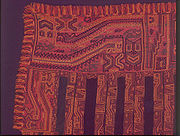
Funeral bundle
Encyclopedia

Burial
Burial is the act of placing a person or object into the ground. This is accomplished by excavating a pit or trench, placing an object in it, and covering it over.-History:...
, practiced by the Paracas culture
Paracas culture
The Paracas culture was an important Andean society between approximately 800 BCE and 100 BCE, with an extensive knowledge of irrigation and water management. It developed in the Paracas Peninsula, located in what today is the Paracas District of the Pisco Province in the Ica Region...
of the Peru
Peru
Peru , officially the Republic of Peru , is a country in western South America. It is bordered on the north by Ecuador and Colombia, on the east by Brazil, on the southeast by Bolivia, on the south by Chile, and on the west by the Pacific Ocean....
vian Andes
Andes
The Andes is the world's longest continental mountain range. It is a continual range of highlands along the western coast of South America. This range is about long, about to wide , and of an average height of about .Along its length, the Andes is split into several ranges, which are separated...
. The well-preserved funeral bundles of the Paracas have allowed archaeologists to study their funeral
Funeral
A funeral is a ceremony for celebrating, sanctifying, or remembering the life of a person who has died. Funerary customs comprise the complex of beliefs and practices used by a culture to remember the dead, from interment itself, to various monuments, prayers, and rituals undertaken in their honor...
rituals in detail.
The naked body of the deceased is bundled in the fetal position
Fetal position
Fetal position is a medical term used to describe the positioning of the body of a prenatal fetus as it develops...
before rigor mortis
Rigor mortis
Rigor mortis is one of the recognizable signs of death that is caused by a chemical change in the muscles after death, causing the limbs of the corpse to become stiff and difficult to move or manipulate...
sets in. A long strip of coarse cotton cloth was then wrapped around the body. Along with the bodies, different kinds of memorabilia have been found, including clothing, food, scraps of cloth or clothed dolls with religious embroidered motifs, and small badges of gold, and these "gifts" form the nucleus of the bundle.
In adult burials, one usually finds on this nucleus an additional layer, formed of pieces of ceremonial garments, decorated with embroideries and protected by several sheets of cotton fabric. These were cooked and tied with cord to facilitate the transportation of the bundle to the burial site. Facing the bundle, mourners would place between one and seven ceramic
Ceramic
A ceramic is an inorganic, nonmetallic solid prepared by the action of heat and subsequent cooling. Ceramic materials may have a crystalline or partly crystalline structure, or may be amorphous...
pieces. A pole or a cane indicated the precise place of the burial. Individuals of major status received more textile gifts and, in this case, the number of layers increased substantially: up to three successive layers could be added onto the nucleus. These layers, and in particular the last one, usually contained decorative embroidered cloaks.
The burials have a collective character, as it is thought that related individuals were generally buried together in the caverns dug in the rock
Rock (geology)
In geology, rock or stone is a naturally occurring solid aggregate of minerals and/or mineraloids.The Earth's outer solid layer, the lithosphere, is made of rock. In general rocks are of three types, namely, igneous, sedimentary, and metamorphic...
or in the sand
Sand
Sand is a naturally occurring granular material composed of finely divided rock and mineral particles.The composition of sand is highly variable, depending on the local rock sources and conditions, but the most common constituent of sand in inland continental settings and non-tropical coastal...
. In several cases, it has been determined that remains were transported and re-interred some years after death. Burial areas are located next to established living places. Often, an area that was inhabited earlier by the living was reused for the dead, and the ruins of houses and public buildings were often used for this purpose.

